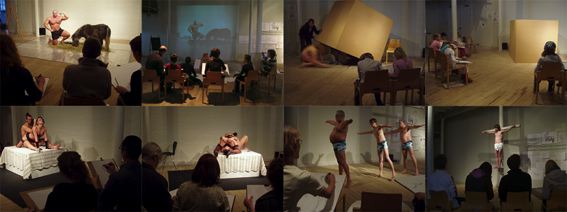
CROQUIS - Performative Art for the People!
A work by Ondrej Brody & Kristofer Paetau, 2006
View the Quicktime CROQUIS Posing Video HERE

CROQUIS - Performative Art for the People!
A work by Ondrej Brody & Kristofer Paetau, 2006
View the Quicktime CROQUIS Posing Video HERE
5 drawing sessions:
1.- Bodybuilder & Pony
a bodybuilder posing with a pony.
2.- Porn Couple
no penetration just suggesting different sexual positions.
3.- Aerobic
Two fat men and a skinny trainer in underwear.
4.- Model in the Box
A nude model disappears inside a cardboard box and remains there for the duration of the drawing session.
5.- Jesus
A model posing on the cross. The model should look like Jesus. One of the pillars in the space is used as the vertical part of the cross.
Popular Art?
Not to be confounded with populism, real popularity seems impossible to achieve within the context of contemporary art. By re-injecting the obsolete artistic expression of model drawing in a performative (institutional) context we provoke misunderstanding from both 'conservative' and 'progressive' art publics.
Conservative versus Progressive?
CROQUIS contains two levels of production that blend into each other. On a 'conservative level' we are using a traditional way of learning and producing art (croquis drawing) as an encourageing strategy to operate on a 'progressive level': a performative and participative context of art production.
Art for the People and the Elite?
By injecting small amounts of poison into sick entities we encourage them to react in a (self) critical way.
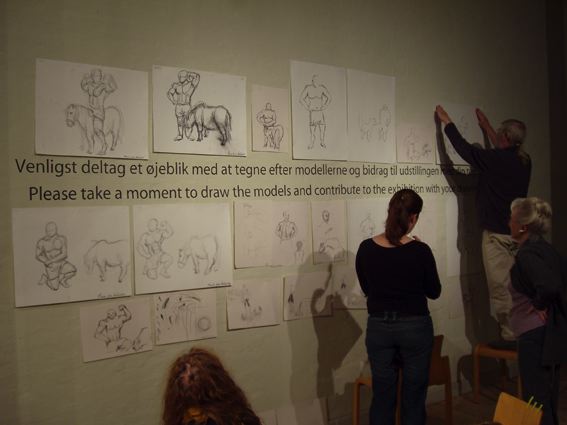
CROQUIS INTERVIEW BY HEIKE WETZIG, BERLIN 2006
How do you interpret populism and popularity that are - as you see it - excluded from contemporary art?
KP: There is a lot of populism in contemporary art, but not much popularity. Populism is mainly speculation and - for the most part - wishful thinking. Popularity is real, it affects our everyday imagination and life.
OB: The audience of the contemporary visual art scene is very limited and inconsiderable. I am not interested in its jejune constitution. I would like to reach a broader public, challenging populism and popularity. Nevertheless, wanting to become more popular is like politics in the third world. Reaching uninformed public/voters can be dangerous. The voters are ignorant, illiterate, etc.; it can be risky to play with their stereotypes, since their notion of art is limited and primitive. Politicians tend to be populists, because it is an effective way to reach the public, and it is the only way to reach a broader public quantity. Finally, coming to the term popularity: In my opinion, the only way to become truly popular is to be at least partially a populist. The problem is more to balance being populist with a more "responsible" approach.
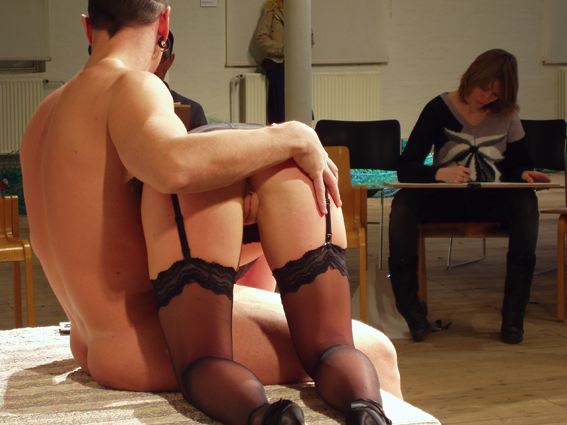
Is there any complaint in your statements about contemporary art?
KP: There are a lot of things that merit to be criticized in contemporary art, and since (as I think) not enough critics are doing a good job, artists should also take part in that responsibility. There's a lot of talk about artists as curators, but art critique seems much more important to me nowadays. Unfortunately, it is not a glamorous exercise, so people are not interested in doing it.
OB: It's rather a complaint that is dealing with the framework of the system, not with art itself but the framework in which art functions.
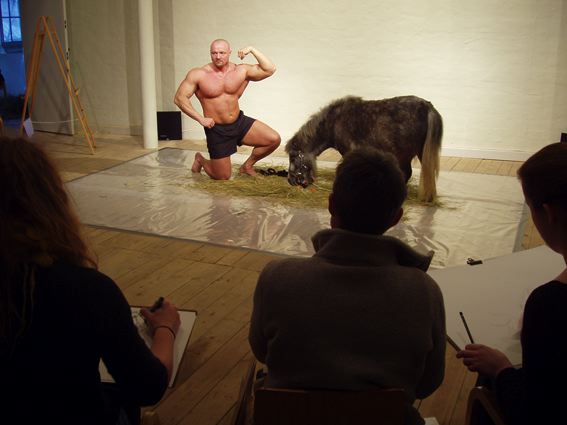
Tell us about the five Croquis situations: Where did they take place, who came as the audience, and which reactions did you recognize?
KP: The Croquis drawing sessions took place in Kunsthallen Brandts in Odense, Denmark, in a group exhibition called “Reality, 10.55 Odense". The audience was mixed. Some people came especially in order to draw because of the Art Center’s publicity in newspapers and in the local art schools and evening classes. Some people who were visiting the group exhibition joined the Croquis sessions spontaneously. The reactions were very individual; most drawers were concentrated and serious. In between the live sessions we projected a lifesize video with a frontal recording of the different poses. To our surprise people actually sat down in the exhibition to draw after the videos as well.
OB: Basically, we were present during the live sessions that constituted the most important part of the project, so I can describe only the situations at that particular time. The Croquis was an attempt to formulate an alternative format of involving the public into an exhibition; an alternative format of an exhibition. The audience that came to draw was composed mainly of people invited or organized by the Kunsthalle and partly of any people, random visitors of the institution who liked the situation and started to draw on the spot. Croquis - that is: drawing nude models - was and still is in some places an old fashioned method used in the educational system of the art academies. It is an educational method supposed to teach the students how to draw; a common stereotype in art education. This makes it an interesting tool of approach to an amateur audience that accepts drawing lessons as a stereotype of art education. Drawing remains one of the constant and basic disciplines or mediums in contemporary art for the amateur and professional public. During the live sessions it seemed to be working quite well. The visitors were attracted by the unusual models and started to interact directly: to draw.
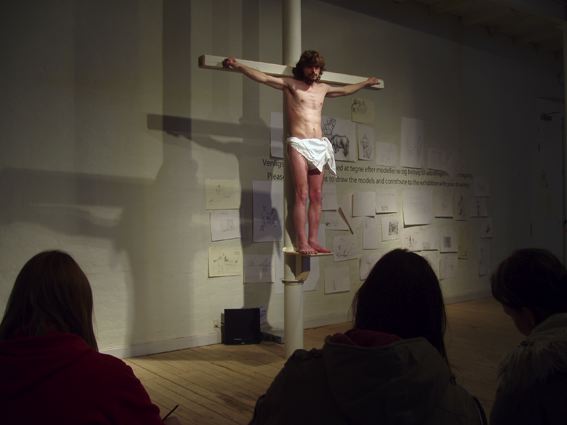
What did you expect as results of the Croquis project?
KP: To make people draw and reflect about the situation in which they had been drawing; to make them reflect on the meaning of their drawings in this specific situation and on their own function as a participating audience. It was also about making people hesitate about what and where the art was in this project.
OB: Some projects have a strong provocative facet. Beyond this "provocative" layer lies a structure related to the basic topic. It might be quite simple then but also demanding for an audience - that usually sticks to the outer facet without tasting anything of the structure - to simplify the project. One important aspect of our projects is that they cause quite a lot of discussions - but at the end the people don't want to deal with them.
The result of the Croquis project was that what took actually place during the audience's interaction within the situation. When they were directly participating in the process of drawing.
Another aspect of the project was that the audience was encouraged to install their drawings on the wall and so, symbolically, be part of the exhibition as artists - authors.
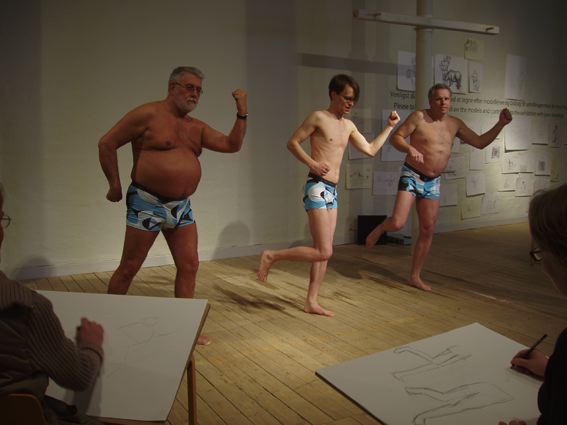
Please give us a general idea of your strategy toward the art market! Let me explain: With the Croquis sessions, you got a provocative course. Even more you did this with former actions, in Licking Curator's Ass, Kristofer's vomit action at the Art Forum opening and Ondrej's co-shitting in the National Gallery in Prague; an acting out of your own bodies in public art environments. Yet, you camouflage yourselves now as honorable, offering drawing lessons?
KP: The art market is not worth that much attention. It is much more important to make a certain attitude visible in the work. It is about openness and courage, about going beyond prejudices and taking responsibility for what you do. This doesn't mean that we are a reproach to morality, but sometimes it is necessary to jump from the frying pan into the fire, in order to make visible something that is wrong or problematic. The most common situation, in my opinion, is that we don’t even see all the ‘bullshit’ anymore because it’s so close to us, so much part of the everyday power structures of our life that we just accept it without questioning it.
OB: Those were different projects. I have different interests, layers if you want, and these actions (shitting, vomiting, licking, etc.) are just part of one layer. I don't like the comparison of the Croquis with the vomit and shit actions. These were reflected quite much in countless discussions and publications in the national newspapers and public discussions; nevertheless, these projects are not related to the Croquis... - The art market? We are not very much involved in the art market. - In the Croquis project there is nothing honorable or camouflaged. The Croquis project was just an evolved version of what we did in Antwerp a year ago (Akt Saloon, 2005). There is, maybe, between us a common desire to act critically and self-critically as an ongoing strategy that helps us to evolve and react to different situations. The art system is one of these topics. Nevertheless, the Croquis project was not particularly critical in any respect.
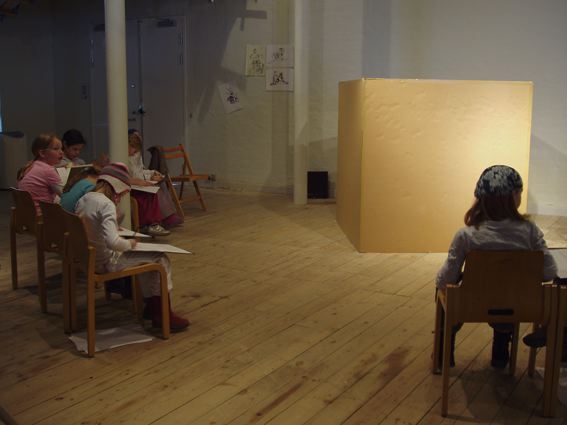
From the scenes to be drawn - but I didn't see the live show - I've got the impression of a not very subtle dealing with the societal issues as such; they seemed to be turned into a kind of fake, doublets of the actual human situation transferred into a strong visual appearance. So, was the invited audience manipulated, anyhow? You had committed professional porn actors. Would you have got different reactions from a focused public if you had shown a real scene? Is the difference between reality and fake your interest at all?
KP: I don’t understand what you mean by fake here. Of course, the shifts in expectations and in values are interesting, and the whole thing was for sure a setup… Concerning the porn actors, I think that it is important not to satisfy the audience’s voyeurism and consumerism. We wanted them to participate and to reflect – not just to enjoy a spectacle passively.
OB: About the audience involved in the Croquis project: Its not true that it was fake. Yes, they were partly organized by the institution, but also random visitors were attracted by the situation and started to draw on the spot. - About the models: The porn scene - it was not necessary to invite a professional porn couple, but it was important to hire people who would be able to perform the way they did, professional porn actors were the most effective and simple solution... It was a drawing session, not a porn session; we needed this absurd moment of somebody suggesting a sexual position. A still position... The Model In The Box exercise was especially staged for children to confront them with the challenge to draw someone they couldn't see - or to draw simply the box. It was their choice... but I feel like defending myself without any reason.
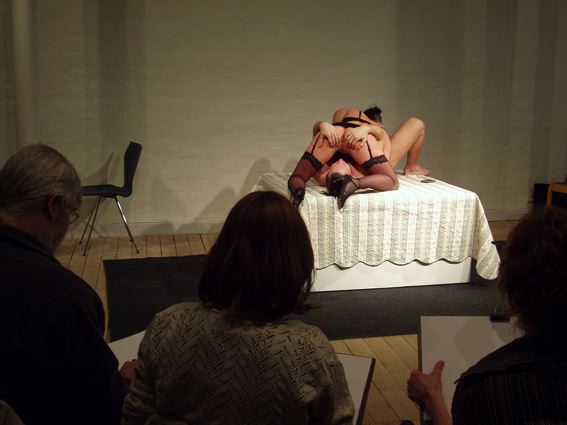
How did you start as artists, how is your co-operation working?
KP: My first important project was the “Salon Picasso” exhibition in April 2004, which was also my first collaboration with Ondrej, who proposed to join me and to film the installation of the exhibition. It was the beginning of a series called "Re-Institutionalize" which I was doing in collaboration with you, Heike, making an interview about each project, in a similar way to this interview that we are making right here... I think that friendship is crucial for my work and has always been crucial in the entire art history as well. It’s about having a fruitful dialogue that makes you progress and it’s about mutual trust and faith – which are absolutely necessary in order to take risks.
OB: We are fighting a lot... This is a different topic...
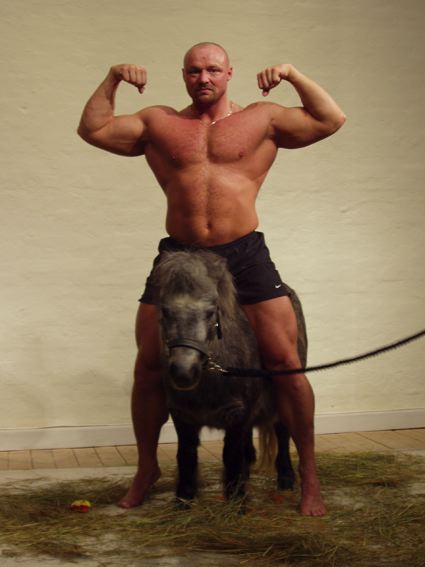
The CROQUIS project took place within the group exhibition ”Reality, 10.55 Odense”, 17.02.06 - 30.04.06 at Kunsthallen Brandts in Odense, Denmark. The exhibition - dealing with “relational art“ - was curated by Lene Burkard & Maia Damianovic.
View the Quicktime CROQUIS Posing Video HERE